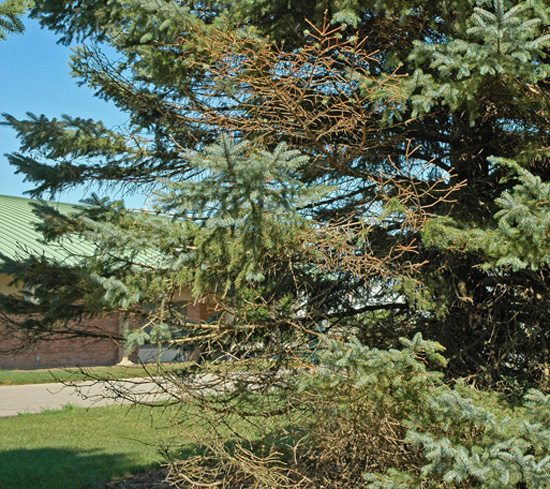Issue 17, September 28, 2009
Spruce Canker
The most common disease problem we see on spruce in Illinois is caused by a stress pathogen. We generally cause the stress by planting spruces in the wrong place. According to Michael Dirr in Manual of Woody Landscape Plants, spruces have shallow, spreading root systems and "prefer a moderately moist, well-drained soil." Some spruce species are more tolerant of dry conditions than others, but as a whole, spruces do not grow well in hot, dry conditions. Throw in a soil with low organic matter and put the tree in an exposed site, possibly in a new housing development, and you have a stressed tree. Drought stress also will predispose the tree to infection.
Cytospora (Leucostoma) canker is one of the most common diseases in Illinois landscapes. It is definitely the most common one we see on spruce. Although it will occur on young trees, it is more common on trees at least 15 years old.
Cankers are dead areas on branches or trunks. They may girdle and kill the branch or they may only partially limit movement of water and nutrients. On spruce there is usually a sappy exudate associated with the canker, but this sap is a thin layer, not the large blobs of sap associated with some insect pests such as pine moths. The wood under the bark of a tree with Cytospora canker is brown (dead) rather than green or white. The disease infects lower limbs first, slowing moving up the tree, killing branches as it moves. The entire branch is killed, usually killing tips of the branch first. The image shows a tree with dead branches as a result of Cytospora canker. Disease progression is slow. Most trees lose a limb each year to the disease. Species affected include mostly Colorado blue and Norway, but other spruce species, as well as Douglas-fir, balsam fir, hemlock, larch, and red and Eastern white pine may have this canker disease. A University of Illinois fact sheet, Cytospora or Leucostoma Canker of Spruce, RPD No. 604, is available on-line.

This pathogen is thought to move into roots and then progress up the tree. It may also enter on wounds in the top of the tree. You cannot eradicate it from an infected tree. Management of Cytospora canker involves removing dead branches and trying to improve tree vitality. Do some sleuthing to find out what conditions are stressful to the tree. Correct as many of these conditions as possible. Fungicides are usually of little value in control of this disease.--Nancy Pataky
Author:
Nancy Pataky